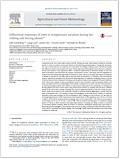| Journal Article |
 |
|
| Article Title | Differential responses of trees to temperature variation during the chilling and forcing phases | | Author | Eike Luedeling, Liang Guo, Junhu Dai, Charles Leslie and Michael M. Blanke | | Year | 2013 | | Journal Title | Agricultural and Forest Meteorology | | Institution | Elsevier B.V. | | Volume | 181 | | Pages | 33– 42 | | Call Number | JA0553-14 | | Keywords | Chestnut, Cherry, Walnut, chillR, Partial Least Squares regression, Phenology |
|
| Abstract: |
| Temperate-zone trees must fulfill cultivar-specific chilling and heat requirements during the dormant
period, in order to produce leaves and flowers in the following growing season. Timing and accumulation
rate of chill and heat are understood to determine the timing of spring events, but both processes
are difficult to observe in dormant tree buds. Where long-term phenological observations are available,
Partial Least Squares (PLS) regression offers a statistical opportunity to delineate phases of chill and
heat accumulation and determine the climatic requirements of trees. This study uses PLS regression to
explore how the timing of spring events of chestnut in China, cherry in Germany and walnut in California
is related to variation in the daily rates of chill and heat accumulation, as calculated with horticultural
models. Dependent variables were 39 years of flowering dates for chestnuts in Beijing (China), 25 years
of cherry bloom in Klein-Altendorf (Germany) and 54 years of walnut leaf emergence in Davis (California,
USA). These were related to daily accumulation rates of chill, calculated with the Dynamic Model, and
heat, calculated with the Growing Degree Hours Model. Compared to an earlier version of the procedure,
in which phenological dates were related to unprocessed temperature data, delineation of chilling and
forcing phases was much clearer when using horticultural metrics to quantify chill and heat. Chestnut
bloom in the cold-winter climate of Beijing was found to depend primarily on the rate of heat accumulation,
while cherry bloom in the temperate climate of Germany showed dependence on both chill and
heat accumulation rates. The timing of walnut leaf emergence in the mild-winter climate of California
depended much more strongly on chill accumulation rates. Chilling (in Chill Portions = CP) and heat (in
Growing Degree Hours = GDH) requirements determined based on PLS regression were 79.8 ± 5.3 CP and
13,466 ± 1918 GDH for chestnut bloom in Beijing, 104.2 ± 8.9 CP and 2698 ± 1183 GDH for cherry bloom
in Germany, and 37.5 ± 5.0 CP and 11,245 ± 1697 GDH for walnut leaf emergence in California. Spring
phases of cherry in Klein-Altendorf and especially chestnut in Beijing will likely continue to advance
in response to global warming, while for walnut in California, inadequate chilling may cause delays in
flowering and leaf emergence. Such delays could serve as an early-warning indicator that future productivity
may be threatened by climate change. The R package ‘chillR’ makes the method used in this study
available for wider use. |
|